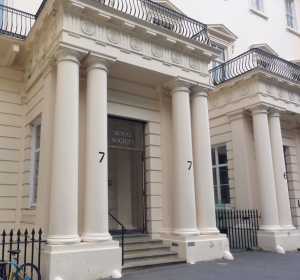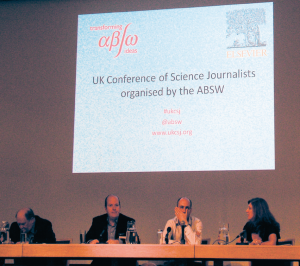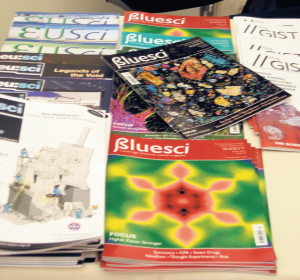WEDNESDAY, 3 OCTOBER 2012
“Science journalists are worth their weight in gold,” pronounced Martin Fewell, deputy editor of Channel 4 News, which would make his science correspondent Tom Clarke worth approximately £2 million. Unsurprisingly, there was not much disagreement from the audience, considering this was at the UK Conference of Science Journalists organised by the Association of British Science Writers (ABSW). The second such conference, organised following the success of the World Conference of Science Journalists was held in the auspicious halls of the Royal Society and brought together hundreds of journalists, editors, scientists and students to discuss issues and develop their professional skills.Fewell was part of a panel of editors at the conference discussing whether or not science punches its weight in the newsroom. He saw great benefit in having science-trained reporters not only for science stories, where they can dig deeper, ask the right questions and explain complicated issues to the public, but also for other stories where they can contribute a scientific perspective. On the other hand, Kenny Campbell, editor of Metro and also part of the panel, doesn’t employ any science journalists. He believes it is an advantage to have non-specialists writing to make it easy for anyone on the Northern line at 8am to understand. With 4.8 million readers to entertain and engage with each day, he plays to the audience and wants “more pictures of mice with ears on their backs”. His suggestion to aspiring science journalists was to become a general journalist first and find out what the public are interested in, rather than deciding to focus on science. But, according to panellist Ian Katz, deputy editor at The Guardian, the public is interested in science stories, and not just sensational ones. On the Guardian website nearly as many people read science stories as read about politics or travel despite science having the smallest team working on it. In a survey, Guardian readers said they wanted to see more stories about science and foreign news, and fewer stories about celebrity gossip (which makes you wonder whether they were telling the truth or not).
Later, there was a session focusing on the Leveson inquiry into media practices and ethics and how it would affect science journalism. Fiona Fox, director of the Science Media Centre, laid out some of the problems she saw with science journalism. She had previously appeared before the inquiry and from her enthusiastic (and rapid) manner it was easy to see why she had been asked to slow down by Lord Leveson, who was “concerned that smoke seems to be emanating from the shorthand writer.” One of the key points she made was the damage done by journalists seeking to balance opinions. By giving equal airtime to the ‘lone maverick’ and the respected scientist who is representative of 99.9 per cent of the scientists in the field, it presents the idea that the scientific community is divided and unsure. She used the reporting of a potential link between the MMR vaccine and autism as an example. While the small (and later shown to be flawed) study and its proponents were not taken seriously by the vast majority researchers and GPs, the continuous debate presented by the press caused a large change in the public perception. At the Leveson inquiry, she had presented these problems and also a 10-point list of guidelines that had been produced with both scientists and journalists. These covered relatively simple but widespread problems in science reporting, such as mentioning the size of a study, giving absolute risk as well as relative risk (think ‘Cupcakes double risk of cancer’) and distinguishing between correlation and causation.
The Association of British Science Writers had organised a stand for several student science magazines to publicise their work between sessions. Alongside BlueSci were EUSci (Edinburgh), Bang! (Oxford), The GIST (Glasgow), Au Science (Aberdeen) and I Science (Imperial). BlueSci is in fact the oldest of the bunch, having been around for eight years and 25 issues, whereas The GIST had just published its first issue. From talking to other editors it was clear that none of the magazines were struggling for contributors or advertising revenues and that student science journalism was in good health.
The day ended with the debate ‘Is science journalism special?’ which led to conflicting views. William Cullerne Brown, founder of Research Fortnight, lambasted science journalism for focusing so much on discoveries, likening it to football journalists writing only about goals. He suggested that stories are being missed where science is not working so well, like the drop-off in drug discovery. This was echoed by Connie St Louis, president of the ABSW, who said that most science journalists are actually science communicators. Without a true investigative aspect, it can’t be called journalism and that we need real journalism to expose the flaws within science. This was exemplified later in the evening at the ABSW awards, where the award for scientific investigative reporting had only a single nomination. However, Evan Davis, presenter of the Today programme, disputed that investigative reporting is the highest form of journalism. He blamed the Watergate scandal (and the film All the President’s Men) for stoking journalists’ egos and proposed that communicating is a more important aspect of journalism than investigation. In that regard, he believed science journalism was healthy. One thing the panel did agree on was the danger of being too close to sources. Science journalists are usually on very close terms with scientists, in a way that would not be acceptable for political correspondents. This prevents them from seeing the flaws in the system. The example used by Evan Davis was the economics reporters who failed to foresee the financial crash because they were too close to the experts.
In the background throughout all the sessions was the tapping of laptop keyboards and the twitching of thumbs. A few audience members were live-blogging the sessions, but most people were on Twitter, updating 140 characters at a time. While vocal debates were emanating from the stage, silent ones were spreading via WiFi, as the room full of science communicators were doing what they do best.
Recordings of all the sessions, as well as blogs and tweets have been collected together on ukcsj.org
Ian Le Guillou is a 4th Year PhD student in the Department of Biochemistry
“What I love about communicating science is the opportunity to tell untold stories. Finding an idea, thinking creatively about how it can make an interesting story and then investigating it gives me a rush of excitement. When I see the final article posted or printed it gives me sense of accomplishment, especially when it provokes comments and e-mails from people who read it. I have reported on everything from obscure robotics research that may help coordinate disaster rescue, to revealing scientific misconduct. All of these stories matter to people and the public relies on good science journalism to find out about them. As an editor I don’t always go out and report on such stories myself; sometimes I have an idea and act as a coordinator to enable someone else to write a story – but editors, too, play important role in telling such stories.
Another great thing about communicating science – and science journalism in particular – is the opportunity to be involved in such a lively and engaged community of people. Science journalists have many meetings, discussion groups and conferences - like the UKCSJ – where one can air their grievances, learn new skills and meet like-minded people who work on similar projects.”
– Mico Tatalovic, deputy editor at SciDev.net and BlueSci alumnus 2006-2008



